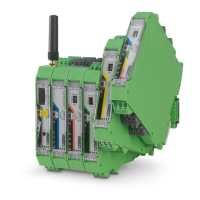RAD-...-IFS
142 / 198
PHOENIX CONTACT 105542_en_05
Penetration
The type of wall encountered also influences the attenuation of the wireless signal. The fol-
lowing constructions adversely affect the wireless signal, for example:
– Hollow lightweight walls with aluminum-lined insulation
– False ceilings with metal or carbon fiber panels
–Lead glass
– Insulation glass (Thermopen)
– Glass with a metal coating
– Steel objects
– Fire walls
– Elevator shafts and staircases
Each material has a different degree of attenuation. However, the following typical values
provide a rough guide.
Figure 8-12 Reduction of radio waves when penetrating a wall
Table 8-7 Attenuation of different materials
Obstacle Typical attenuation at
2.4 GHz [dB]
Typical attenuation at
868 MHz [dB]
Wood, plaster, glass, plastic,
uncoated, without metal
3...4 1...2
Brick, chip board 3 ... 5 1 ... 3
Brick wall, 16 cm 6 ...8 2 ... 4
Concrete wall, 16 cm 15 ... 20 9 ... 11
Reinforced concrete wall, 16 cm 20 ... 30 11 ... 20
Forest, 1 m, see 8.16 “Practical
examples”
9 ... 14 4 ... 8
Heat-absorbing glass with metal
coating
40 ... 50 30 ... 40

